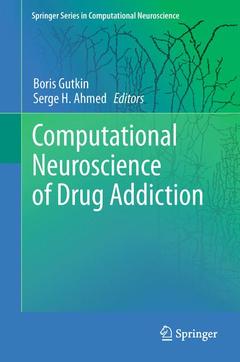Description
Computational Neuroscience of Drug Addiction, 2012
Springer Series in Computational Neuroscience Series, Vol. 10
Coordinators: Gutkin Boris, Ahmed Serge H.
Language: English
Subject for Computational Neuroscience of Drug Addiction:
342 p. · 15.5x23.5 cm · Paperback
342 p. · 15.5x23.5 cm · Paperback
Description
/li>Contents
/li>Comment
/li>
Foreword: P Dayan.- Part 1 – Pharmacological-based models of addiction.- Chapter 1. Simple deterministic mathematical Model of maintained drug delf-Administration behavior and its pharmacological applications. V.L. Tsibulsky* and A.B. Norman.- Chapter 2. Intermittent Adaptation : A mathematical model of drug tolerance, dependence and addiction. A. Peper .- Chapter 3. Control theory and addictive behavior. D. Newlin, P.A. Regalia, T.I. Seidman, G. Bobashev.- Part 2 – Neurocomputational models of addiction.- Chapter 4. Circuit models of addiction: receptors and neural dynamics in nicotine self-administration. M. Graupner and B. Gutkin.- Chapter 5. N Dual-system learning models and drugs of abuse. N.D. Daw and D.A. Simon.- Chapter 6. Modeling decision-making systems in addiction. Z. Kurth-Nelson and A. D. Redish.- Chapter 7. Computational models of incentive-sensitization in addiction: Dynamic limbic transformation of learning into motivation. J. Zhang, K. C. Berridge, and J. W. Aldridge.- Chapter 8. Understanding addiction as a pathological state of multiple decision making processes: a neurocomputational perspective. M. Keramati, A. Dezfouli and P. Piray.- Part 3 – Economic-based models of addiction.- Chapter 9. Policies and priors. K Friston.- Chapter 10. Toward a Computationally Unified Behavioral-Economic Model of Addiction. E.T. Mueller, L.P. Carter and W.K. Bickel.- Chapter 11. Simulating Patterns of Heroin Addiction within the Social Context of a Local Heroin Market. L. Hoffer, G. Bobashev and R. J Morris.
These books may interest you

Animal Models of Drug Addiction 158.24 €



